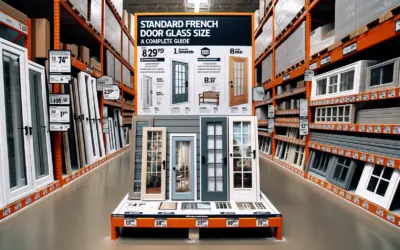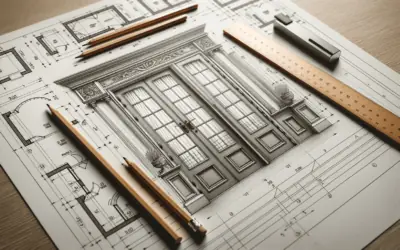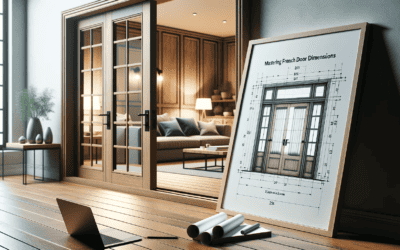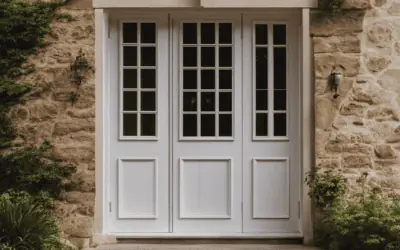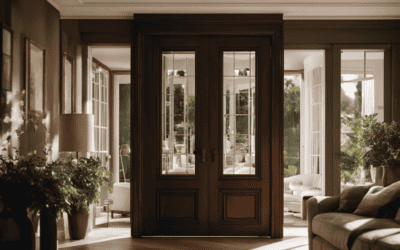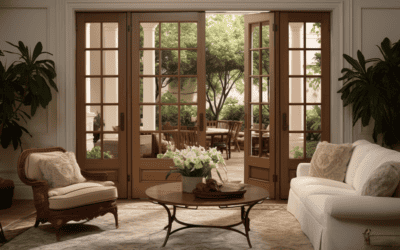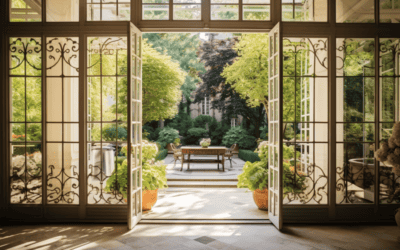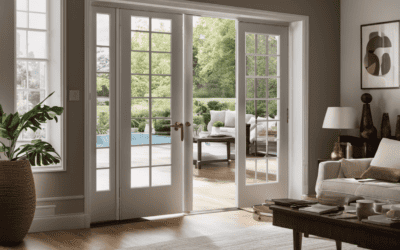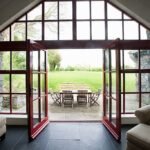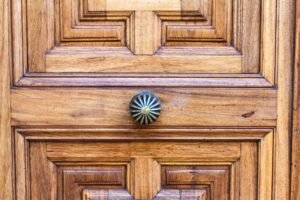 French doors with knobs set in the centre are a signature feature of traditional European homes. This specific design is thought to have originated from door latches that predated the invention of door knobs. The knob at the door’s midpoint provides more security, with a crossbar stretched across its width for even more reinforcing support.
French doors with knobs set in the centre are a signature feature of traditional European homes. This specific design is thought to have originated from door latches that predated the invention of door knobs. The knob at the door’s midpoint provides more security, with a crossbar stretched across its width for even more reinforcing support.
A central knob also presents a more straightforward installation for latching technology, which is beneficial for keeping doors shut. Moreover, having this type of knob adds an aesthetically pleasing appeal to any entryway and thus supplies a touch of refinement to an otherwise plain area.
Why Does Australia Have High Door Knobs?
Higher door knobs in Australia are believed to serve a practical purpose for taller people and be used as an optical trick to create an illusion of a lower ceiling height. It is also thought that these higher door knobs were made to prevent certain animals from opening doors.
According to the Australian Standard AS 1428.1, all door handles should be installed between 900-1100mm above the finished floor. This indicates that doors of all types should typically have higher mounted handles in Australia due to taller average heights.
Further research suggests that knobs and handles on properties 70 years or younger are likely around 1000mm from the floor, which is well within the recommended range. As a result, this may indicate why there is typically a higher mounting of door knobs in Australia compared to other countries.
In conclusion, having a higher-mounted handle is essential for accessibility purposes as per the Australian Standard, and Australian heights could be attributed as another reason for this practice.
What Is The Point Of A Dummy Door Knob?
A decorative dummy door knob is hardware that adds a beautiful accent to your doors. Unlike functional knobs, dummy knobs do not contain any mechanical latch workings and don’t turn or rotate in any way – they provide an illusion of a working knob.
Using dummy door knobs allows you to create an attractive and stylish look for your doors with minimal effort. Depending on the style and finish you choose, it can add to your home’s classic or modern feel. What’s more, in many cases, complete dummy door knobs come as double sets with two handles, one for each side of the door, perfect when needing quick access to both sides. When installing them, you only need to place them on the surface – no tools or drilling are necessary!
How Does A Door With A Knob In The Center Work?
A door with a knob in the centre typically works the same way as a door with a knob on one side. Here is an outline of how a door with a knob in the centre functions:
• When the doorknob is turned, the spindle rotates and compresses the clip spring, which retracts the bolt from the doorframe and allows you to open it.
• Upon releasing the doorknob, the spring re-engages and pushes the bolt back into the doorframe, again holding the door shut.
• If a lock is on the right-hand side of the knob, you can turn it with a key to engage its locking mechanism and prevent someone from opening it from outside.
• To install a centre door knob on a wood front door, you must drill a hole in its centre and attach it using screws.
In conclusion, the turning of the doorknob rotates the spindle that compresses springs connected with bolts; these bolts, when retracted, open up to allow entering or exiting; if the lock changes over orientation, it could be used for maximum security; doors at least made of wood has capable installation considering its drilling holes & attaching knobs through screws for better usability.
Why Do Some Doors Have The Doorknob In The Middle Of The Door?
Experts and individuals have suggested numerous reasons why door knobs may be placed in the middle of a door. This design not only looks attractive and balanced, but it also benefits its user. Primarily, centrally positioning the knob allows for an easier grip when pushing or pulling the door shut, resulting in convenience and ease of use.
Additionally, depending on the particular door model, having a knob in the centre could enhance security by allowing multi-point locking systems with connections to both sides of the frame. And, for doors that open outward, it increases safety by allowing people to exit quickly without worrying about maneuvering around a handle situated on one side.
Furthermore, it is worth stating that knobs are usually placed at the edge of doors due to ease of manufacturing, leverage, latch mechanisms and more practical aspects. However, having them in the centre has admittedly been advantageous with specific designs, such as ones with multi-point locking mechanisms or those opening outwards.
In conclusion, the placement of door knobs in the middle is often due to comfortability factors, security, and visual appeal, particularly when considering some European-style locks and outward-facing doors.
The Advantages Of Using A European Center Door Knob
Advantages of using a European centre door knob include:
• Sleek and modern design: These knobs offer a streamlined aesthetic that can complement different interior design styles.
• Easy to install: They come with hardware, and many tutorials can be found online.
• Three-way adjustment system: This system allows you to adjust up, down, in and out, and left to right until the correct fitting is achieved.
• Accessibility: As they do not require as much strength as traditional knobs when turning them, they are good options for homes with older adults or those with disabilities.
However, it is essential to note that while they make great additions aesthetically, they may not provide the same level of security as deadbolts or other locks and should only be used on interior doors where security isn’t a high priority.
Why A Door With A Doorknob In The Middle Might Be The Right Choice For Your Home
Installing a door with a doorknob in the middle can provide convenience, aesthetic charm, and security to any home. Here is what you should consider before making your decision:
Accessibility: If you have family members or guests with limited arm or mobility needs, a doorknob closer to the centre of the door may be easier for them to maneuver. This knob is often easier to reach when using a wheelchair or approaching from an angle.
Aesthetics: Doors with a knob in the middle can create an attractive and timeless design within your home. It was popular in Georgian times and can look incredibly stylish in vintage-inspired homes.
Security: Depending on your type of lock, doors with knobs in the centre can provide equal or more excellent protection than those with knobs on the sides. For example, deadbolt locks are horizontally locked and vertically unlocked. Some require this positioning specifically to work correctly.
Personnel Access: Consider who will most likely use this door often — if small children or curious visitors enter your home from time to time, then opting for knobs instead of levers might prevent them from unlocking efficiently due to its size and difficulty level required to turn it correctly.
Ultimately, whether installing a door with a doorknob in the middle is suitable for your home will depend on what needs it must fulfil and the preferences of those who will frequently utilize it. Assessing its pros and cons can help you make an informed decision that best suits your household’s needs!
Understanding The Functionality Of Center Door Knobs: A How-to Guide
A centre door knob, also known as a passage door knob, is a type of door hardware with no locking mechanism and is usually found on doors where privacy or security is not required, e.g. closet or pantry doors.
This guide will provide an overview of how to understand the functionality of such knobs.
The main section of a centre door knob consists of a cylindrical shape that can be grabbed for turning purposes. The knob is connected to a spindle that passes through the latch mechanism, allowing for opening and closing once the knob has been rotated. Usually, the latch mechanism within these knobs is installed on either side of the door and consists of two elements – a strike plate and a latch bolt that comes together when the door is closed.
When selecting centre door knobs, there are several factors to consider, such as size, shape and material used in making it, as well as the finish applied. These include flat or satin black finishes, brushed or satin nickel looks and rustic or modern designs, to name just a few among the many selections to choose from.
In terms of installation, they are frequently held up via hinges which come in different varieties, including butt hinges, continuous hinges and pivot hinges.
All in all, centre door knobs serve their purpose very well regarding simple yet functional types of hardware for any application – whether residential or commercial use! By understanding all components attached to this type of knob and the factors for selection and installation, you can guarantee your project’s success every time!
Diy: How To Install A Centre Door Knob On Your Own
A centre door knob set (including screws and fasteners), a screwdriver, a measuring tape, a pencil, and a chisel/drill (if necessary) are all materials you will need to install a centre door knob.
Steps For Installing A Centre Door Knob
1. Measure and mark the centre of the door where you want to install the knob. Use a measuring tape and a pencil to ensure the mark is level and at the right height.
2. If the door has a hole for an existing knob, skip stepping 4. If not, you may need to use a chisel or drill to create a spot the same size as your centre knob set – be careful not to damage the door while doing this!
3. Once you have created the hole, insert your centre knobs from the front of the door and attach the backplate to the other side. Make sure it’s adequately aligned to appear centred once in place! Secure with screws if necessary.
4. Attach your centre doorknob to its spindle that protrudes through your door with screws from behind – double-check that it is correctly aligned before securing it with said screws!
5. Test your new doorknob by locking/unlocking it several times to make sure everything’s functioning correctly before considering this job done!
Resources On How To Fit A Centre Door Knob
For some extra help, why not take advantage of these resources that provide detailed guidance on fitting a centre door knob correctly:
• The House Nameplate Company has an easy-to-follow video guide for folks looking to fit one onto their wood front doors!
• Wikihow also has an excellent article featuring step-by-step instructions on installing different types of doorknobs – including central ones!
• DIY with Michael Borders has another video tutorial specifically tailored towards standard fitting knobs – which can also be adapted if installing one of its major counterparts!
• Last but perhaps most helpful: Carlisle Brass shares yet another video providing specific instructions on how to fit those controllers into your doors – this could be precisely what you’d been looking for all along!
Remember: Take your time for maximal finishes & good luck with your DIY project!
Boost Your Home’s Curb Appeal With A Center Door Knob For Your French Front Door
Select the right style and finish: A centre door knob for your French front door comes in various designs, completions, and components. Ensure you pick an appropriate manner and finish to coordinate with your home’s engineering structure and other outside highlights.
Clean and clean the door fittings: Before introducing the middle entryway handle, clean any filthy spots around the handle, and utilize metal cleanser on the entryway fittings to make them gleam new.
Paint the front door: Painting your front entryway is a straightforward cash-sparing approach to give your home a speedy lift in effort appeal. Pick an inconspicuous tone that mixes with your home’s current material, or add an unforeseen shading to your primary entryway with a vibrant tint.
Include containers: Adding holders to your front entryway is a fast and straightforward approach to improve your home’s check intrigue promptly. Top them off with an assortment of plants, for example, blossoms, succulents, grasses, ferns, lavender or arbs. This will make an energizing spot close to your fundamental passageway.
By following these tips, you can upgrade the control intrigue at the point of appearance of your home with a centre passage handle for your French entrance.
Related Articles:
Charm and Elegance Unleashed: The Timeless Appeal of Timber French Doors
Timber French doors are a timeless architectural element that grace homes with elegance, natural warmth, and beauty. With their characteristic large glass panels surrounded by wide stiles and rails made of solid wood, these doors create an inviting transition between...
French Doors Buying Guide: An In-Depth Look
French doors are a popular choice for homeowners looking to enhance natural light, ventilation, and aesthetic appeal. With their characteristic large glass panes and narrow dividing frames, these elegant doors create an inviting indoor-outdoor flow. This comprehensive...
Standard French Door Glass Size: A Complete Guide
French doors are an elegant and timeless architectural feature known for their decorative glass panes that allow ample natural light into a space. But what are the standard glass sizes for these iconic doors? Understanding the typical dimensions of French door glass...
How Big Can French Doors Be in CM? A Complete Guide
French doors are a classic and elegant addition to any home. With their large glass panes and delicate dividers, they allow ample natural light into a space while providing a beautiful architectural focal point. But before installing these iconic doors, it's important...
Mastering French Door Dimensions: Your Ultimate Guide to Exterior Sizes
French doors are a classic and timeless architectural feature that can add elegance, charm and functionality to a home. As their name suggests, they originated in France but have been popular in the US and elsewhere for over a century. I'm a homeowner looking to...
What Are Active or Stationary French Doors
Welcome to our guide on active and stationary French doors! Picture this: you're standing in your home, longing for elegance and functionality. That's where French doors come in. These beauties consist of two door panels, one that swings open (the active side) and one...
How to Stop French Doors Slamming
French doors constantly slamming shut, causing frustration and potential damage? We've got you covered. With some maintenance and simple adjustments, you can prevent your doors from slamming and enjoy their beauty and functionality for years. Regular inspection and...
From Classic to Contemporary: The Impact of French Doors on Modern Architectural
Discover the impact of French doors on modern architectural design. From classic elegance to seamless indoor-outdoor flow, unlock the beauty of contemporary living.
The Architectural Impact of French Doors: A Historical Perspective
Discover the architectural influence of French doors! From Europe to America, their impact on design is unparalleled.
French Door Sizes: A Complete Guide to Standard and Custom Dimensions
As I step through the threshold of knowledge, let me guide you through the world of French door sizes. This comprehensive article explores the standard dimensions for exterior and interior French doors and the exciting possibilities of custom sizes. I'll also reveal...



